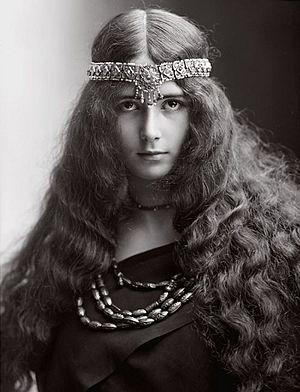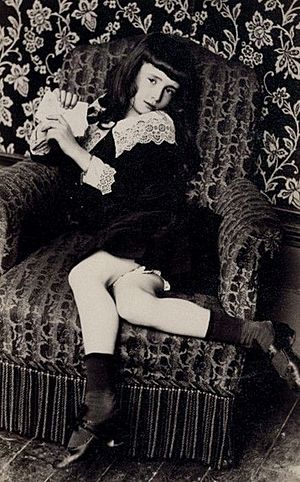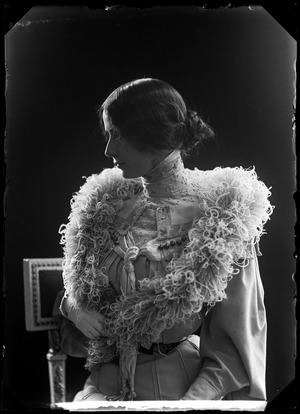Cléo de Mérode facts for kids
Cléopâtre-Diane de Mérode (born September 27, 1875 – died October 17, 1966) was a famous French dancer. She lived during a time called the Belle Époque, which means "Beautiful Era." Many people called her the "first modern celebrity." She was also one of the first women whose photos were shared all over the world. Photographers like Nadar and Léopold-Émile Reutlinger helped make her image famous.
Contents
Cléo de Mérode's Early Life and Dance Training
Cléo de Mérode was born in Paris, France. Her birthday was September 27, 1875. Her mother was Baroness Vincentia Maria Cäcilia Catharina de Mérode. Cléo's father was Theodor Christomannos, an Austrian judge. She didn't meet him until she was older.
Cléo was raised Catholic and her family called her "Lulu." When she was eight, she started studying dance. She trained with the Sisters of Saint-Vincent-de-Paul. At just eleven years old, she made her first professional dance appearance. This was at the famous Paris Opéra.
Becoming a Star: Fame and Style
Cléo de Mérode became well-known for her beauty and style. People loved her glamorous look, even more than her dancing skills. Her picture started appearing on postcards and playing cards.
When she was 16, Cléo introduced her special hairstyle. It was a chignon, a bun worn low at the back of the neck. This hairstyle became very popular in Paris. It also started rumors that she might be missing an ear. This was because the style covered her ears.
Artists and Photographers Capture Her Image
Many famous artists painted Cléo de Mérode. These included Henri de Toulouse-Lautrec, Edgar Degas, and Giovanni Boldini. Sculptors like Alexandre Falguière also created art of her. A wax mask of her face is kept in a museum in Brussels.
Some of the most famous photographers took her picture. These included Félix Nadar and his son Paul Nadar. Their photos helped spread her image around the world.
The Falguière Sculpture and Public Reaction
In 1896, a sculpture of Cléo de Mérode caused a lot of talk. The artist, Alexandre Falguière, made a life-size marble statue called La Danseuse. Cléo said she only posed for the head of the statue. She strongly denied posing for the body.
This event was discussed throughout her career. Later, she even included the sculpture in one of her stage shows. Today, the sculpture can be seen at the Musée d'Orsay in Paris.
International Performances and Mixed Reviews
In the summer of 1896, Cléo de Mérode performed in a ballet-pantomime called Phryné. This show was in Royan, a seaside town. That same year, readers of L'Illustration magazine voted her "Beauty Queen." She received many more votes than other famous women.
Despite some public discussions, Cléo became a global star. She performed in many countries across Europe and in the United States.
Performing in New York City
In 1897, Cléo arrived in New York City. She performed for a month at Koster and Bial's Music Hall. Reporters followed her everywhere. Girls on the street would ask for her autograph.
Her performances in New York received mixed reviews. The press praised her beauty but said her dancing was not strong. Munsey's Magazine wrote that she had "the most successful failure of the season." Cléo disagreed, saying she pleased Americans greatly. She also said Americans "know nothing about dancing." Even with the mixed reviews, she earned much more money than her usual salary in Paris.
Later Career and Legacy
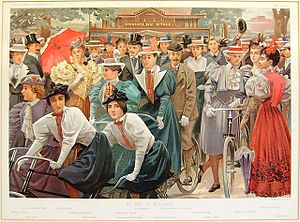
In 1898, Cléo de Mérode won first prize at a New York Camera Club exhibit. She was named the most beautiful woman in Paris. In 1900, she performed a special "Cambodian" dance at the Exposition Universelle in Paris. She also appeared in two films, one of which was colored by hand. Both films showed her dancing.
At the peak of her fame, she chose to dance at the Folies Bergère. This was a bold move for a ballet dancer. Her performance there gained her even more fans. In 1906, it was reported that 50 million photos of Cléo de Mérode had been sold. One company in Berlin alone made 4 million photos a year.
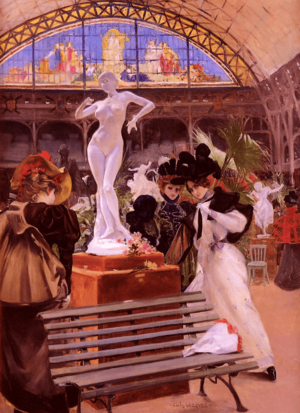
During World War I, Cléo entertained wounded soldiers. She continued dancing until her late forties. In 1924, she retired to Biarritz, a seaside town in France.
Comeback and Retirement
In 1934, she made a comeback performance at the Alcazar theater. She danced in a show called La revue 1900. She later taught ballet. Cléo finally retired from public life in 1965, at 90 years old. As a hobby, she made small statues of dancers and shepherds.
In 1955, she wrote her autobiography. It was called Le Ballet de ma vie, which means The Dance of My Life. In 1964, she was photographed by Cecil Beaton for Vogue magazine.
Cléo de Mérode never married or had children. She was close friends with the musician Reynaldo Hahn. She also had a long-term companion, Luis de Périnat, a Spanish sculptor and diplomat. She lived with her mother until her mother passed away in 1899. Cléo de Mérode was also a vegetarian.
Cléo de Mérode passed away on October 17, 1966, in her Paris apartment. She was 91 years old. She is buried at Père Lachaise Cemetery in Paris. Her gravestone has a statue of her, made by Luis de Périnat. The statue shows her mourning her mother, who is buried in the same spot.
See also
 In Spanish: Cléo de Mérode para niños
In Spanish: Cléo de Mérode para niños
- Women in dance
|


